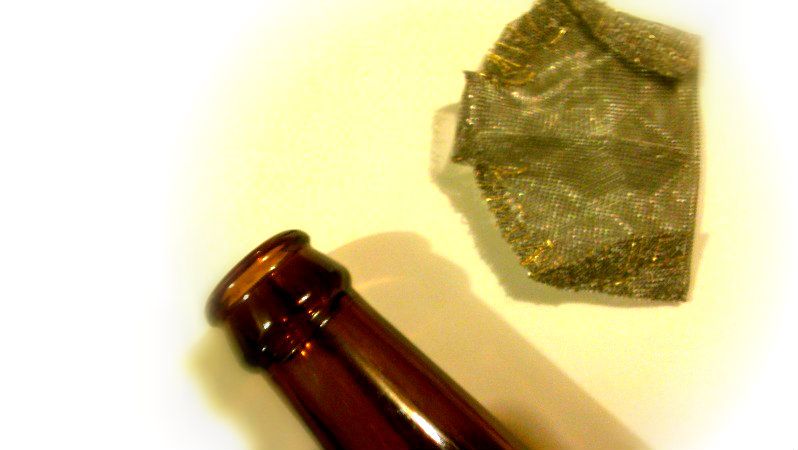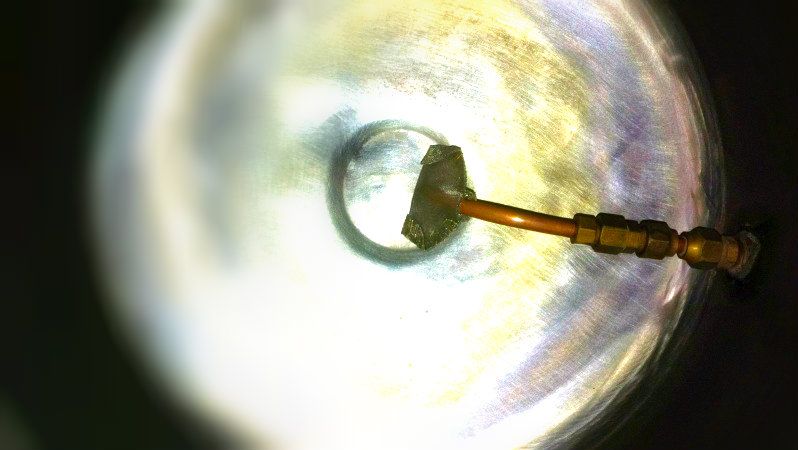***SEE EDIT BELOW***
Awhile back I had made a Hop Taco for my kettle based on plans I found from Knights of the Mash Fork. It seemed to work fairly well for keeping the hops out of the pickup tube and out of the carboy, but it made clean up very difficult. It was cumbersome and awkward, I couldn't really clean it in place, I couldn't clean the kettle with it in place, and removing the pickup tube was difficult since the hop taco would inhibit spinning it. Once free the Hop Taco was strewn with hop particles making it hard to clean as they would get caught on the wire ends that were frayed around the edge (also great for stabbing your hand during removal, cleaning, and replacing). If I was able to get it clean, I then had to try to get it put back together again which proved to be just as difficult as removing it. Finally, after a long and tiring double brewday I walked away leaving the hops, orange zest, and trub in the bottom of the kettle and didn’t go back to clean it until it was too late. There was quite a bit of mold and what looked like possible rust on the taco and I ended up just throwing it out since it was difficult to use anyways.
Awhile back I had made a Hop Taco for my kettle based on plans I found from Knights of the Mash Fork. It seemed to work fairly well for keeping the hops out of the pickup tube and out of the carboy, but it made clean up very difficult. It was cumbersome and awkward, I couldn't really clean it in place, I couldn't clean the kettle with it in place, and removing the pickup tube was difficult since the hop taco would inhibit spinning it. Once free the Hop Taco was strewn with hop particles making it hard to clean as they would get caught on the wire ends that were frayed around the edge (also great for stabbing your hand during removal, cleaning, and replacing). If I was able to get it clean, I then had to try to get it put back together again which proved to be just as difficult as removing it. Finally, after a long and tiring double brewday I walked away leaving the hops, orange zest, and trub in the bottom of the kettle and didn’t go back to clean it until it was too late. There was quite a bit of mold and what looked like possible rust on the taco and I ended up just throwing it out since it was difficult to use anyways.
I still needed a way to keep the hops from clogging my pickup tube though. I made a version of the Hop Spider that proved useless. Most of my hops would just get caught in the upper layer of nylon and remain suspended above the wort so I would have to remove the spider and dip it into the boiling wort with each addition. After only a few batches that mechanism was relegated to the same fate as the Hop Taco. Since then I have been using paint strainer bags or nylon sacks I got from the produce section (designed for keeping fruit free from fruit fly attacks while they sit out); they worked well until I had to clean out all those hop sacks after each brewday, some of which get caught under/around my pickup tube.
All of this leads me to a new dilemma, what is the easiest way to add hops to the boil allowing for the best extraction and aroma, as well as the easiest clean up afterwards while keeping hops (as well as spices) out of the pickup tube and carboy? This has lead me back to the Hop Taco, just redesigned. I found a small fine mesh Stainless Steel strainer at Walmart for $7. The SS ensures that it won’t react negatively to the low pH and hot temperatures of the boiling wort as well as keeping it from rusting. The fine mesh should keep more particles out, and I am hoping that this includes pellet material as well. The smaller size allows for greater ease in cleaning as well as removal, and less to clean once the brew session is done (the larger one had more surface area to clean and more wire fray to catch hop pieces on).
For this version I used soft brass wire 0.41mm in thickness. Many of the models I found online call for SS thread, but I can’t find any, and the copper wire I used on the last rendition was way too thick which made it difficult to get a tight stitch, and with the smaller size on this edition, the stitching needs to be tight. I did break the wire a couple times, but was able to get a fairly tight stitch, and I doubled the coverage by looping around the outside first, then passing through along the edge as well. I crimped the edges to leave a lip where the opening is for a hose clamp to grab onto and keep it on the pickup tube.
Now all I need to do is find some time to brew with it! I've got a pound of 2012 Simcoe pellets, ½# Meridian and Calypso, and quite a few pounds of Chinook and Cascade homegrown hops waiting in the freezer, as well as a pound of Mosaic on the way. And with nothing hoppy it looks like I am needing to brew an IPA very soon, which will be much easier with my new wort chiller that I am going to fit with a whirlpool option to attach to the new March Pump I am getting for Christmas.
***EDIT: When used for a Dopplebock with whole leaf hops it worked great. When used on a 10 gallon IPA with copious amounts of pellet and leaf hops it clogged shut rendering the pump and ball valve useless. Will be trying a SS braid in its place to see how that works.***
***EDIT: When used for a Dopplebock with whole leaf hops it worked great. When used on a 10 gallon IPA with copious amounts of pellet and leaf hops it clogged shut rendering the pump and ball valve useless. Will be trying a SS braid in its place to see how that works.***



No comments:
Post a Comment